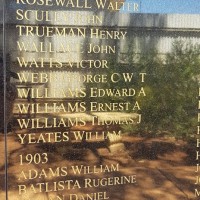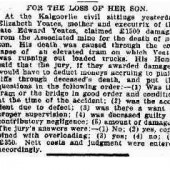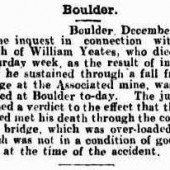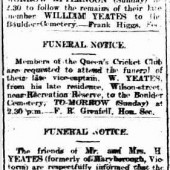William “Edward” YEATES
Age at Death22
Date Of Death29 November 1902 : Reg 784/1902
Place Of BirthMaryborough, Victoria
OccupationTrucker
Name Of Mine On Which Last Employed
Associated GM, Kalgoorlie-Boulder, Western Australia
Diagnosis or cause of accident
Yeates was pushing trucks from the cyanide plant across a bridge to a backfill waste pass when the bridge collapsed. He sustained internal injuries and died the next day.
Place Of Burial
Boulder Cemetery, Western Australia
Submitted by
Eric Chamberlain and Ian Hodkinson (volunteers)
MSW
Single
Cause of Death
Mine Accidents
Father
Henry YEATES
Mother
Elizabeth THOMAS
Other Information
1902 'BOULDER.', The West Australian, 9 December, p. 7. Boulder. December 8.
The inquest in connection with the death of William Yeates, who died last
Saturday week, as the result of injuries that he sustained through a fall from a
bridge at the Associated mine, was concluded at Boulder to-day. The jury re
turned a verdict to the effect that the deceased met his death through the collapse
of a bridge, which was over-loaded, and which was not in a condition of good repair at the time of the accident.
1902 'A TRUCKER'S DEATH.', Kalgoorlie Miner, 9 December, p. 2.
ATTRIBUTED TO NEGLIGENCE.
The inquest into the cause of the
death of William Yeates, who died
from the result of an accident sustain
ed at the Associated mine on Novem-
ber 28 was resumed at the Boulder
Police Count yesterday before Mr. A.
J. Evans (acting coroner), and Messrs.
De Baun (foreman), Thomas Daly, and
Thomas Edwards, jury.
Sergeant Moore conducted the inquiry.
Mr. W. Jones appeared for the re-
latives of the deceased.
Henry Yeates, brother of the de-
ceased, gave evidence of identification.
James Gilbert Napier, a trucker on the
Associated, deposed that on November
28 he was working with the deceased,
Richard Temby and Richard Leish-
man. They were trucking from the
cyanide vats across a bridge to a pass.
Between 8.30 and 9 a.m., after running
a "rake" of five trucks to the pass they
ran the empties back. They were
running five more to the pass when
the accident happened. Witness and
deceased were pushing behind; Leish
man was on the back corner, and Tem-
by was in the front ready to stop the
trucks. The bridge broke away about
the centre of the five trucks. Yeates
fell with the trucks. He fell on top
of one of them, and he was jammed
by another. Yeates was conscious
when released. He said he felt hurt
inwardly. He was taken to the candle
room. This was the first time witness
had worked on the bridge. To Mr.
Jones: The four of us were working
for Mr. Fitzpatrick, the contractor for
emptying the cyanide vats. Up to
November 29 they had been working
in another part of the mine. Han-
chant, Fitzpatrick's partner, ordered
us to go to work on the bridge. This
morning was the first time I saw trucks
run over the bridge, The accident
happened on the bridge. The bridge
was laid on trestles, but in the centre
there was a heap of mullock. Some
of the men from below had removed
some of this mullock and tipped it
down the pass. The loaded trucks
would weigh about a ton each. There
would be 15ft. to 20ft. between each
trestle. Yeates was performing his
ordinary duties as a trucker at the
time of the accident, and in my opin-
ion none of us were guilty of contribu-
tory negligence. I believe the under
ground manager was about the place
that morning. To the jury: The
trucks would weigh between 4 cwt. and
5 cwt. each.
Richard Temby gave corroborative
evidence. To Mr Jones: There was
supposed to be a mullock support un
der the bridge. I saw mullock there
a week before the accident. The
company's men removed the mullock
and threw it down the pass. The mul-
lock was a support. I did not see any
support put in to replace the mullock.
The trucks were about 4 cwt. empty,
and a ton to 24 cwt. loaded. To the
Inspector of Mines: The mullock came
close up to the timber of the bridge.
I cannot say the extent of the heap.
When the accident occurred the trucks
were over the centre support of the
bridge on the shaft side.
Dr. Bridgeford deposed that he ex-
amined the deceased soon after the
accident and twice during the day.
Death was due to shock caused by in
jury to the abdomen.
William Hanchant, contractor on the
Associated, deposed that on November
28 he started the men trucking out
dirt to the pass. As they were going
out with the second rake of trucks he
saw the bridge collapse. Men started
working on the bridge on the evening
of the 27th. He did not examine the
bridge till after the accident. The
bridge had not been used for three or
four months before the 27th inst. It
was 16 or 17ft. high. The company
took the mullock away from, under the
legs. To Mr. Jones: My partner's
name is Patrick James Fitzpatrick. We
work under specifications (produced).
We are only expected to keep the rails
in repair. We have nothing to do
with construction. There is no limit
to the number of trucks we are allowed
to ran on the bridge. If properly
constructed the bridge should carry as
many trucks as we could put on it.
On the 27th the underground manager
ordered us to truck to the pass across
the bridge. To the Jury : We were
never told not to put more than three
loaded trucks on the line. The five
trucks would be resting on the span
between the two trestles.
Stephen Bradley, engineer on the
mine, deposed that this bridge was
14ft. high. A safe working load on
the line was three loaded trucks. Each
truck empty weighed 5 cwt. and 25
cwt. loaded. He had known of more
than three trucks being run on the
line. He had seen seven pulled out
with a horse about four months ago.
The line had not been used for the
past three months. The cause of the
accident was the overloading of the
structure. To Mr. Jones: There is
no notice up stating what number of
trucks were to be run on the bridge.
The span between the trestles was
28ft. A heap of mullock had accu-
mulated round the legs. It was a
support, but it was not taken into ac
count when building the bridge. The
mullock stiffened the legs. It was
removed by the underground mana-
ger. The structure had no latent
defect. The timber was sound. The
grain was 6 or 8ft. long. The line
was not examined before resuming
work on the 27th. After the accident
I saw one old crack. It was not
enough to endanger the structure with
a safe working load. It was not ap-
parent to an ordinary inspection. The
company built the bridge and kept it
in repair. It was the contractor's
duty to report any defects in the
bridge.
The jury found that the deceased came
to his death through the collapse of a
bridge, the collapse being brought
about by overloading and the bridge
not being in proper repair at the time.






